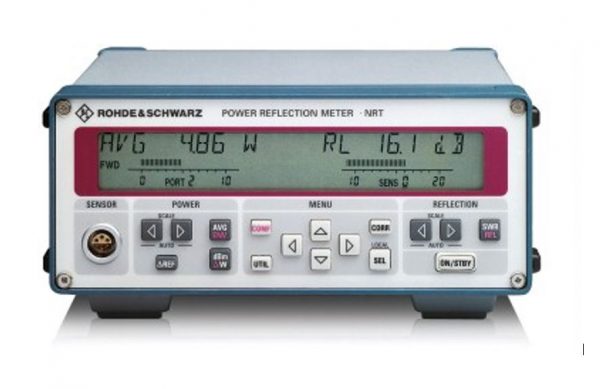Rohde & Schwarz NRT-B3 Power Reflection Meter
Manufacturer: Rohde & Schwarz
Model Number: NRT-B3
The Rohde NRT is a Power Reflection Meter. Due to the large variety of measurement functions and high accuracy it is suitable for classic applications in mobile use as well as for use in research, development, production and quality management. With Power Sensors NRT-Z43 and NRT-Z44, the Rohde NRT is tailor-made to present and future requirements of radiocommunications: the wide frequency range from 200 (400)MHz to 4 GHz covers all relevant frequency bands, the measurement method is compatible with all common analog and in particular digital modulation standards: GSM/EDGE, 3GPP (W-/TD-CDMA), CDMA (IS-95), CDMA2000, PHS, NADC, PDC, TETRA, DECT, DAB, DVB-T and many more.The complete range of sensors of the predecessor model NAP is available for the customary frequency ranges, eg. shortwave; the sensors can be connected via an option. While conventional power sensors can only be used in conjunction with a basic unit, the NRT family is a step further ahead: the sensors are self-contained measuring instruments which are able to communicate with the basic unit or with a PC via a standard serial data interface. Apart from the possibility of operating the sensor directly at the RS-232 or PC Card interface of a PC, this concept provides a number of further benefits: practically maintenance-free basic unit, high immunity to radiated interference - an important feature for measurements in he near field of antennas - and remote operation over very long distances (up to 500 m). With its large display and a manageable number of clearly laid-out keys, operation of the NRT basic unit is extremely easy. Switchover between the main functions is made at a keystroke. Additional settings are selected in three clearly arranged menus, each of which can be accessed at a keystroke. A large variety of functions is available for daily routine measurements: Choice between average power, average burst power, peak envelope power (PEP)and peak-to-average power ratio (crest factor). Switchover between forward power and absorbed power. Measurement of power differences in dB or %. Choice between return loss, SWR, reflection coefficient and reverse-to-forward power ratio in % in reflection measurements. Display of amplitude distribution (CCDF)for modulated signals. Consideration of cable loss between sensor and load. Acoustic SWR monitoring. Indication of maximum and minimum values. Quasi-analog bargraph display. Choice between measurement at the source or at the load. Summary Power measurement on transmitters, amplifiers, industrial RF and microwave generators. Simultaneous display of power and reflection. Measurement of average power irrespective of modulation mode. Measurement of peak power, crest factor and average burst power. Compatible with all main digital standards, eg. GSM/EDGE, 3GPP (W-/TD-CDMA), CDMA (IS-95), CDMA2000, PHS, NADC, PDC, TETRA, DECT, DAB, DVB-T... Intelligent sensors: simply plug in and go IEC625 (IEEE488)bus and RS-232 interface. Digital interface between sensor and basic unit. Direct connection of sensor to a PC. The NRT basic unit comes with an IEC-bus (IEEE488)and RS-232 interface, both to SCPI standard.Three options allow the NRT to be adapted to different applications: An additional test input allows the sensors of predecessor model NAP to be connected,thus covering the frequency range from 200 kHz with power up to 1 kW and above (NRT-B1). Two additional test inputs for sensors of type NRT-Z (option NRT-B2) allow monitoring of up to three test points (to be scanned by manual or remote control). Battery and built-in charger enable mobile use (NRT-B3).

